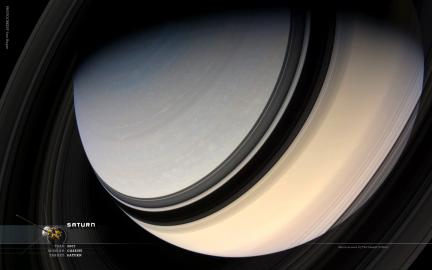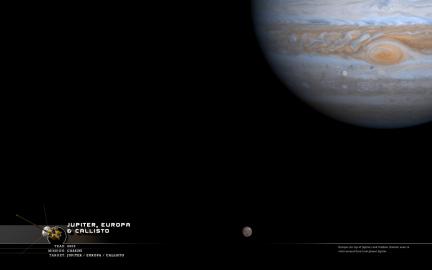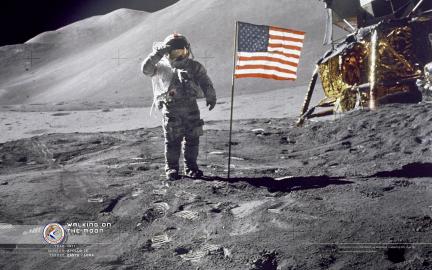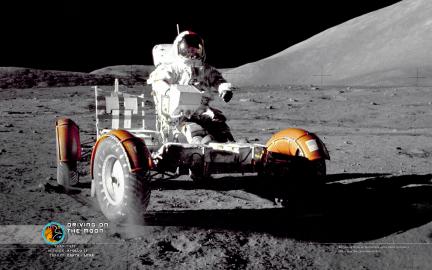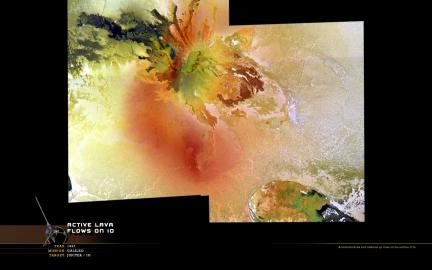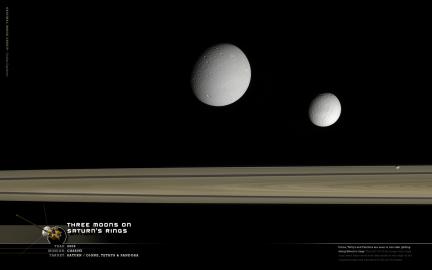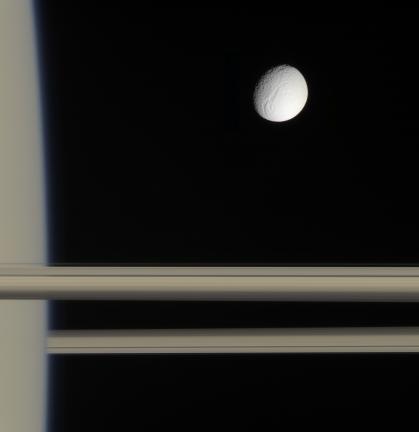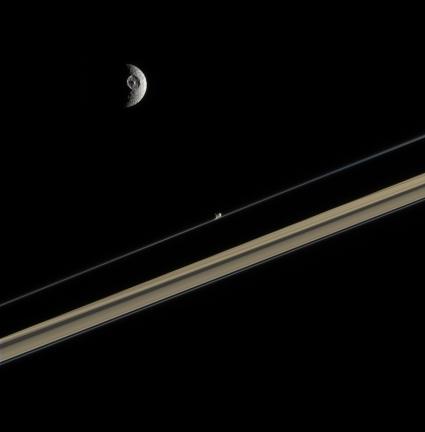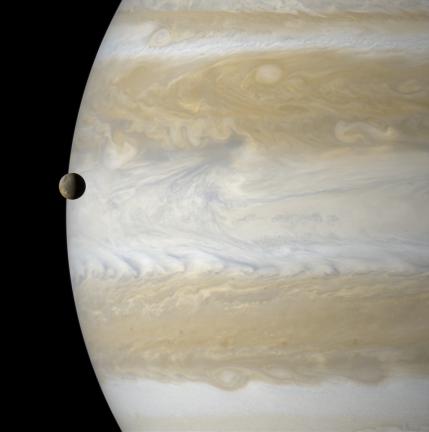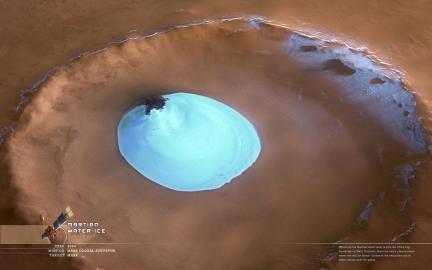 I’m beginning to feel like this isn’t my blog anymore… I keep finding images processed by Gordan Ugarkovic to be among the very best out there. This is definitely the best color image I have seen of details in Saturn’s cloud tops. If you haven’t perused his flickr account, I’d avise you to do so. Go there to see the hires of this image and many others. It is a one-stop-shop for anyone longing to see more color from the Cassini mission http://www.flickr.com/photos/ugordan/
I’m beginning to feel like this isn’t my blog anymore… I keep finding images processed by Gordan Ugarkovic to be among the very best out there. This is definitely the best color image I have seen of details in Saturn’s cloud tops. If you haven’t perused his flickr account, I’d avise you to do so. Go there to see the hires of this image and many others. It is a one-stop-shop for anyone longing to see more color from the Cassini mission http://www.flickr.com/photos/ugordan/
Wallpaper: Saturn Portrait II
Wallpaper: Rhea Portrait
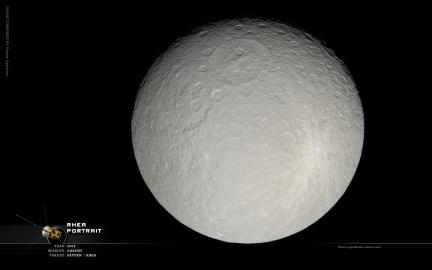 Rhea is the second largest of Saturn’s moons but lacks any of the exciting features of some of the others. It has some of the “wispy” features that have been determined to be ice cliffs on Dione, but they are far less prominent here. Just another big ball of water ice for future earth visitors to mine for resources!
Rhea is the second largest of Saturn’s moons but lacks any of the exciting features of some of the others. It has some of the “wispy” features that have been determined to be ice cliffs on Dione, but they are far less prominent here. Just another big ball of water ice for future earth visitors to mine for resources!
Wallpaper: Tethys Portrait
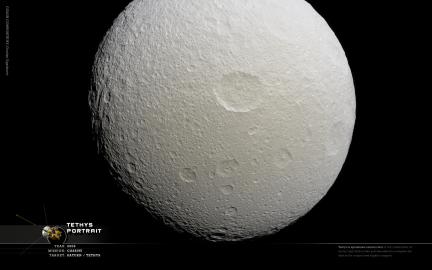 One of the mid-sized moons of Saturn, Tethys, is thought to be composed almost entirely of water ice. Its most remarkable features are Odysseus, a 400 km wide crater and the Ithaca Chasma a 2,000 km long valley that runs across 2/3 of Tethy‘s globe. Those features are not visible in this image, but what is visible is the slight color variation which almost appears as a “dusting” of color on a largely grey body. A curious feature especially considering the radical color variation found at Iapetus. Perhaps this discoloring is a more subtle result of the same event which caused the strange color variation on Iapetus?
One of the mid-sized moons of Saturn, Tethys, is thought to be composed almost entirely of water ice. Its most remarkable features are Odysseus, a 400 km wide crater and the Ithaca Chasma a 2,000 km long valley that runs across 2/3 of Tethy‘s globe. Those features are not visible in this image, but what is visible is the slight color variation which almost appears as a “dusting” of color on a largely grey body. A curious feature especially considering the radical color variation found at Iapetus. Perhaps this discoloring is a more subtle result of the same event which caused the strange color variation on Iapetus?
Mars Reconnaissance Orbiter’s Got Good Eyes
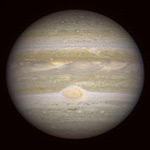 This is a great way to truly understand the capabilities of the Mars Reconnaissance Orbiter. This image of Jupiter is taken from Martian orbit which is 357 million miles away. It is comparable to the what the New Horizons is seeing as it actually approaches Jupiter, which is currently 38 million miles away. So if you were wondering how MRO can get those incredibly detailed images of rovers and landers on the surface from orbit… now you can scratch your head and wonder how it can see Jupiter as good as a probe that is actually approaching a flyby in a few weeks.
This is a great way to truly understand the capabilities of the Mars Reconnaissance Orbiter. This image of Jupiter is taken from Martian orbit which is 357 million miles away. It is comparable to the what the New Horizons is seeing as it actually approaches Jupiter, which is currently 38 million miles away. So if you were wondering how MRO can get those incredibly detailed images of rovers and landers on the surface from orbit… now you can scratch your head and wonder how it can see Jupiter as good as a probe that is actually approaching a flyby in a few weeks.
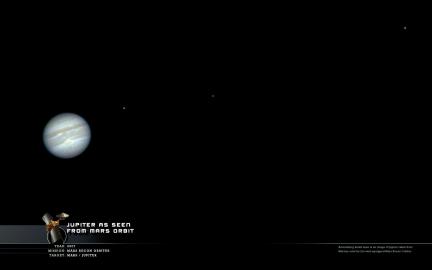
Okay, so not as exciting a wallpaper as most… but it was taken from Mars and you can see (i’m guessing) is Europa, Ganymede and Callisto in the same shot.
Wallpapers: Jupiter and Moons
Wallpapers: Three From Apollo
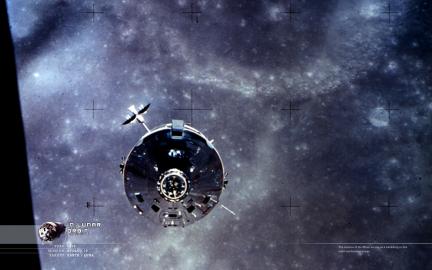 A few decades ago, about 12 men walked upon the surface of another celestial body for the first time in history. At one point, Neil Armstrong looked up at Earth and blotted it out with his thumb and thought the significance of that simple act. “That's home. That's us. On it, everyone you ever heard of, every human being who ever lived, lived out their lives. The aggregate of all our joys and sufferings, thousands of confident religions, ideologies and economic doctrines, every hunter and forager, every hero and coward, every creator and destroyer of civilizations, every king and peasant, every young couple in love, every hopeful child, every mother and father, every inventor and explorer, every teacher of morals, every corrupt politician, every superstar, every supreme leader, every saint and sinner in the history of our species, lived there on a mote of dust, suspended in a sunbeam”. While these were not Armstrong’s words, but instead Carl Sagan’s, it is clear that it is along these similar lines he was thinking.
A few decades ago, about 12 men walked upon the surface of another celestial body for the first time in history. At one point, Neil Armstrong looked up at Earth and blotted it out with his thumb and thought the significance of that simple act. “That's home. That's us. On it, everyone you ever heard of, every human being who ever lived, lived out their lives. The aggregate of all our joys and sufferings, thousands of confident religions, ideologies and economic doctrines, every hunter and forager, every hero and coward, every creator and destroyer of civilizations, every king and peasant, every young couple in love, every hopeful child, every mother and father, every inventor and explorer, every teacher of morals, every corrupt politician, every superstar, every supreme leader, every saint and sinner in the history of our species, lived there on a mote of dust, suspended in a sunbeam”. While these were not Armstrong’s words, but instead Carl Sagan’s, it is clear that it is along these similar lines he was thinking.
It is easy to forget how incredible those moments were as they happened so long ago, and the first of these was some months before I even existed as a person. We have grown accustomed to these images of men walking on the moon, in no small part because a follow up is so long overdue that they seem antiquated or quaint. So it seemed to me that out of 50 wallpapers uploaded it might be appropriate to include man’s first exploration of any of these places as part of the collection.
Wallpaper: Triton Cryo-Volcanos
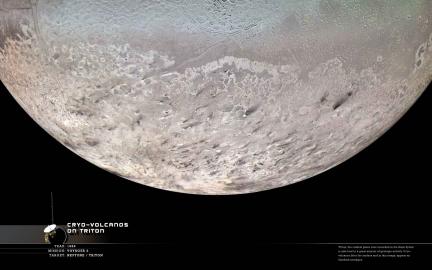 As of this time, Triton (a moon of Neptune) has the coldest temperature ever recorded in human history on any terrestrial surface… -235 C, -391 F. At these temperatures, nobody would have expected anything other than a huge frozen solid ice ball. Instead, Triton is littered with what we now call cryo-volcanos… or cold volcanos. They erupt or eject materials other than molten rock, such as water, ammonia or methane. As we are seeing in places like Titan (who is also suspected of having cryo-volcanos) many characteristics of Earth geology and weather are simulated elsewhere in the Solar System with different materials. On Earth it rains water, but on Titan it rains methane, and likewise on Triton it erupts probably liquid nitrogen instead of magma as it does here on Earth.
As of this time, Triton (a moon of Neptune) has the coldest temperature ever recorded in human history on any terrestrial surface… -235 C, -391 F. At these temperatures, nobody would have expected anything other than a huge frozen solid ice ball. Instead, Triton is littered with what we now call cryo-volcanos… or cold volcanos. They erupt or eject materials other than molten rock, such as water, ammonia or methane. As we are seeing in places like Titan (who is also suspected of having cryo-volcanos) many characteristics of Earth geology and weather are simulated elsewhere in the Solar System with different materials. On Earth it rains water, but on Titan it rains methane, and likewise on Triton it erupts probably liquid nitrogen instead of magma as it does here on Earth.
Only two active cryo-volcanos have been confirmed on Triton, but it is generally assumed that each one of those black smudges visible in this image are the remnants of recently active cryo-volcanos. There are quite a few…
Planetary Society Petitions President
Speaking of stars or wars… here is the next tactic in The Planetary Society’s “Save our Science” campaign, click here for the article. it’s a nice try, but I’m pretty sure he can’t read.
Moon Base Vs Fantastic Martian Future
Stars or Wars
With all the news recently of renewed manned moon missions and the “intention” to send astronauts eventually from there on to Mars, I was thinking of the time frames on these goals. In just proposing going back to the moon, NASA has suggested this goal might take 10 years. Interesting considering that in the 1960’s we announced that goal (absent nearly all the technology to actually do it) and we actually set foot on the moon in 9 years. How it is our technology is nearly 50 years more advanced and yet it will still somehow take us one additional year more to do something we had already done 6 times previous in the 1960’s is beyond me.
Looking past the Moon to Mars I'm guessing will take, optimistically, at least another 5 years beyond that. More realistically… allowing for accidents, budget delays, etc… a manned Mars mission may not take place for 20 years from now. I am 37 right now, which makes me 57 when someone first takes a step onto Martian soil. If at that point, around 2025, we drop off from planetary exploration like we did as a reaction to the Apollo program, well… essentially… I will likely have seen as far into the cosmos as man will have traveled in my lifetime. Unless the atmosphere for this kind of exploration changes considerably in the next 20 years (which could happen) it is hard to imagine that before I shuffle off this mortal coil, that NASA (or anybody) would be willing to tackle a manned mission to places as exotic as Jupiter or Saturn inside of an additional 20 years.
All of these goals listed above would also cost a considerable amount of cash. The budget for a Moon base for instance would likely eat up all resources alloted to NASA and then moving on to Mars anytime thereafter would surely dwarf the kinds of numbers we saw for Apollo – even considering for inflation. I know some books have been written by very reliable people that suggest a manned mission to Mars could be done for 1/10 the cost that NASA tosses about regularly, but everyone knows that government agencies could not (safely) cut corners on these missions. Many would also be unwilling to politically risk the personal responsibility of some colossal failure on such a high profile event in human history. A manned mission to Mars will not be done on the cheap… trust me… there will be no New Horizons economical version on a manned mission to any place other than Starbucks Coffee.
So, considering the available band-width available to the human exploration of space… how do we get to become a space faring species like we see in popular science fiction? How might humanity ever muster up enough resources and dedication to potentially populate the Moon, populate Mars, build cities in Earth orbit, explore the moons of Jupiter and send teams of inquisitive scientists to study the lakes of Titan? The only way I could see any of that happening in such a way that it becomes a part of the everyday human experience, would be for human kind to figure out a way to do away with war.
To even approach some of the more reasonable science fiction visions of humanity’s future would cost not only a whole lot, but would actually require a lion’s share of the full available budget as national defense currently does. It is not hard to imagine that a real human reach beyond terra-fir-ma would actually be more expensive than current or even reagan-era military spending was. So much of human effort, technology and riches are either spent using or developing the machines of war in order to insure each nation’s own national security or ambitions. If you examine much else of what we human’s spend our time and resources on, you will discover that pretty much the only one of those which could theoretically be nullified is the cost of war. No matter the progress of technology, we human’s will still need to pay for social programs, health care, infrastructure… the list goes on. The only major cost of any nation – that is not directly related to some kind of progress or maintenance which is the natural result of actually having a nation or civilization to uphold – is the cost of making or protecting one’s self from an act of war.
So until we figure out how to avoid these conflicts, as well as come up with a system which can guarantee all nations protection from any rogue powers bent on invasion, we will have to keep our larger dreams of a space-faring society to tiny, little, very long and time-consuming steps. The human race has to figure out some way to stop spending a majority of its energy making war and and divert that energy into the greater goals of all sciences. Only then can the fantastic vision of the future that we have had for generations be within the reach of a single lifetime.
Phoenix: Failure Avoided
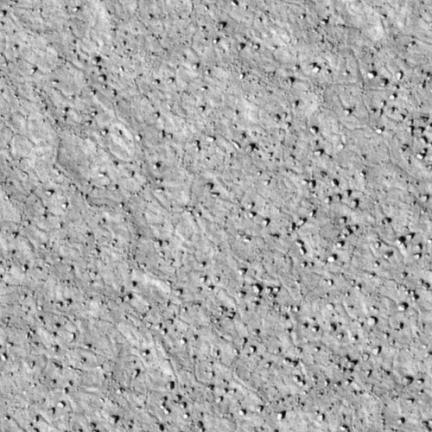
The above image was returned to the team assigned the task of selecting a landing spot for this summer’s launch of the Phoenix lander. This has been considered for years and once the Mars Reconnaissance Orbiter was placed in orbit around Mars, one of it’s highest priority tasks was the image this proposed area. As you can see, what was previously thought to be a fairly flat safe place to put down a lander has turned out instead to be littered with boulders that compare in size to the lander itself. Many missions to Mars in human history have ended in failure, especially when including the many Russian probes which were lost to various problems. Attempting to touch down in this area could certainly have spelled doom for the Phoenix lander and we would never have known without the high resolution eyes of the Mars Reconnaissance Orbiter.
Maybe NASA would have gotten lucky again, but this looks to many as a disaster avoided.
Wallpaper: Dione Portrait
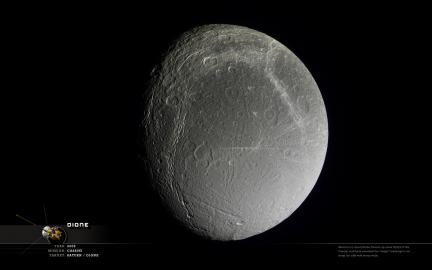 Saturn’s moon Dione seen at almost full disk. Recently the “wispy” markings have been revealed to be giant ice cliffs as seen by the Cassini spacecraft after coming close to 500km from the surface. The cliffs reach as high as several hundred meters high and are thought to be the result of ancient tectonic fractures.
Saturn’s moon Dione seen at almost full disk. Recently the “wispy” markings have been revealed to be giant ice cliffs as seen by the Cassini spacecraft after coming close to 500km from the surface. The cliffs reach as high as several hundred meters high and are thought to be the result of ancient tectonic fractures.
Wallpaper: Io Lava Flows
Wallpaper: Deep Impact Makes Contact
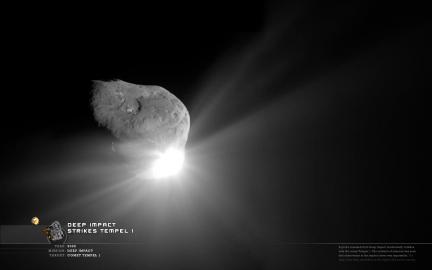 One of the expectations of ramming a space probe into a comet was to be able to see the resulting crater. The Deep Impact collider was released and the Deep Impact probe continued on from a distance to record the impact. What it saw was a blast much larger than expected and was so large that direct visual observance of the resulting crater became impossible. However, the same thing which kept us from seeing some of these results is the same plume of ejected material that has told us that more about this comet’s composition and how the surface materials are held together quite weakly.
One of the expectations of ramming a space probe into a comet was to be able to see the resulting crater. The Deep Impact collider was released and the Deep Impact probe continued on from a distance to record the impact. What it saw was a blast much larger than expected and was so large that direct visual observance of the resulting crater became impossible. However, the same thing which kept us from seeing some of these results is the same plume of ejected material that has told us that more about this comet’s composition and how the surface materials are held together quite weakly.
Beyond: Visions Of The Interplanetary Probes
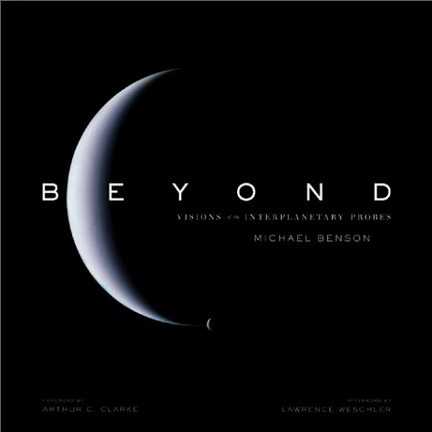
Image Processors on Flickr: Gordan Ugarkovic
Gordan Ugarkovic has a great collection of reworked Cassini images on Flickr. I contacted Gordan about showing some of his images here on wanderingspace and he was ever so gracious. As many people Gordan is “somewhat underwhelmed by the frequency the Cassini Imaging Team releases color composites”, so it is up to excellent freelancers like him to compile this information from the data files which are made public by NASA. Problem is that these images rarely make it to the mass media and we are stuck with the dozen or so color images the NASA imaging teams decide to produce in a year.
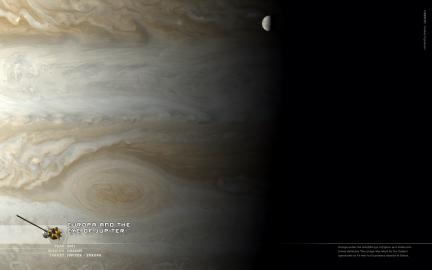
WALLPAPER NOTE: The left 1/3 of the “Three Moons” image was extended in Photoshop using data at the edges of the original image which was cropped to a square format. This “fake” imagery was only applied to that area of the rings and the rest of the image including the moons is actual.
Here are some other images from Gordan which are some of my favorites, but don’t trust my editing… go to the gallery and have a look yourself. For the sake of posterity I have added a permanent link to his gallery on the right side of this blog where you may note that there are already a few others linked. There were two additional ones but the sites have been taken down since I linked to them?! Hopefully the three left will stick around for a while and I will in time add more to the collection.
Tethys and Saturn’s Hazy Limb
Mimas and Prometheus on Rings
Io on Jupiters Edge
Wallpaper: Saturn’s North Polar Region
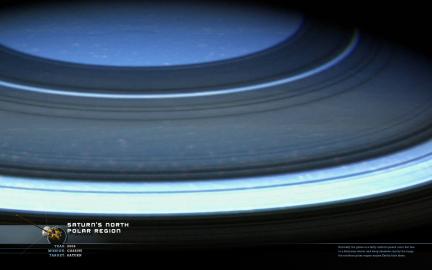 Currently the Cassini spacecraft is orbiting Saturn during Saturnian Winter unlike when Voyager sped by in the 80’s when it saw an almost globally peach colored Saturn. During this winter, the rings tend to keep the region in shadows and the theory goes that this lowers the temperatures and break up the peach colored clouds and “clear” the skies to reveal this blue. If this is the case, we are seeing deeper into the atmosphere here than we do in the areas blanketed by the more peach colored top clouds.
Currently the Cassini spacecraft is orbiting Saturn during Saturnian Winter unlike when Voyager sped by in the 80’s when it saw an almost globally peach colored Saturn. During this winter, the rings tend to keep the region in shadows and the theory goes that this lowers the temperatures and break up the peach colored clouds and “clear” the skies to reveal this blue. If this is the case, we are seeing deeper into the atmosphere here than we do in the areas blanketed by the more peach colored top clouds.
The image shows the northern pole of Saturn and those bands are the shadows of the rings on the cloud tops. You can see some smaller cloud formations in between the shadow gaps which gives a very alien Saturn some Earth-like familiarity.
Wallpaper: Martian Water Ice
Wallpaper: Hyperion Encounter
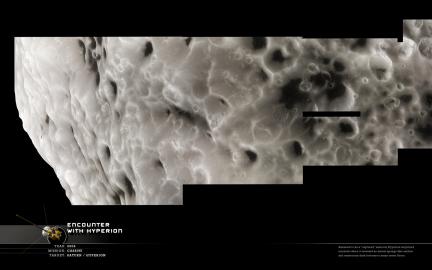 We have all seen plenty of craters in the Solar System but none appear the way they do on Hyperion. As of this time there are only loose theories about the nature and cause of Hyperion’s sponge-like appearance. Brighter outer layers give way to darkened crater bottoms and do this fairly consistently across the entire surface of Hyperion. It is also is second largest irregularly shaped body in the Solar System (#1 being Neptune’s Proteus) and is one of the only chaoticly rotating bodies ever discovered. The spin-axis is so insane that any future visitors to Hyperion will have to wait until they are real near-by to decide where they might be landing as it is actually near impossible to project how Hyperion will be oriented at any given future moment.
We have all seen plenty of craters in the Solar System but none appear the way they do on Hyperion. As of this time there are only loose theories about the nature and cause of Hyperion’s sponge-like appearance. Brighter outer layers give way to darkened crater bottoms and do this fairly consistently across the entire surface of Hyperion. It is also is second largest irregularly shaped body in the Solar System (#1 being Neptune’s Proteus) and is one of the only chaoticly rotating bodies ever discovered. The spin-axis is so insane that any future visitors to Hyperion will have to wait until they are real near-by to decide where they might be landing as it is actually near impossible to project how Hyperion will be oriented at any given future moment.
IMAGE NOTE: The color was overlaid from another image of Hyperion and the is largely artistic.
Wallpaper: Saturn and Mimas
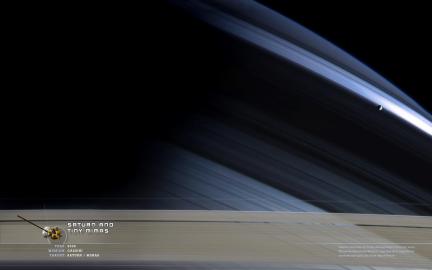 One of my favorite wallpaper images from the Cassini mission. This image almost looks like one of the fantastic Chesley Bonestell images from the 80’s only its not a painting. What you see are Saturn’s rings along the bottom and tiny Mimas floating across Saturnian cloudtops which are being shadowed by the rings. It is thought that these deep shadows, in addition to Saturn currently being in winter, somehow cause less clouds to form in Saturn’s northern hemisphere and create the blueish appearance seen here. When the Voyager’s passed by Saturn in the 80’s the entire globe appeared to be peach colored and lacked any of the blues you see today.
One of my favorite wallpaper images from the Cassini mission. This image almost looks like one of the fantastic Chesley Bonestell images from the 80’s only its not a painting. What you see are Saturn’s rings along the bottom and tiny Mimas floating across Saturnian cloudtops which are being shadowed by the rings. It is thought that these deep shadows, in addition to Saturn currently being in winter, somehow cause less clouds to form in Saturn’s northern hemisphere and create the blueish appearance seen here. When the Voyager’s passed by Saturn in the 80’s the entire globe appeared to be peach colored and lacked any of the blues you see today.
IMAGE NOTE: The left 1/5 of the image (the rings) is a digital extension of the image data found near the edge of the original image. This was done simply to fill out the proportion as the original was cropped to about 4/5 the the width.
